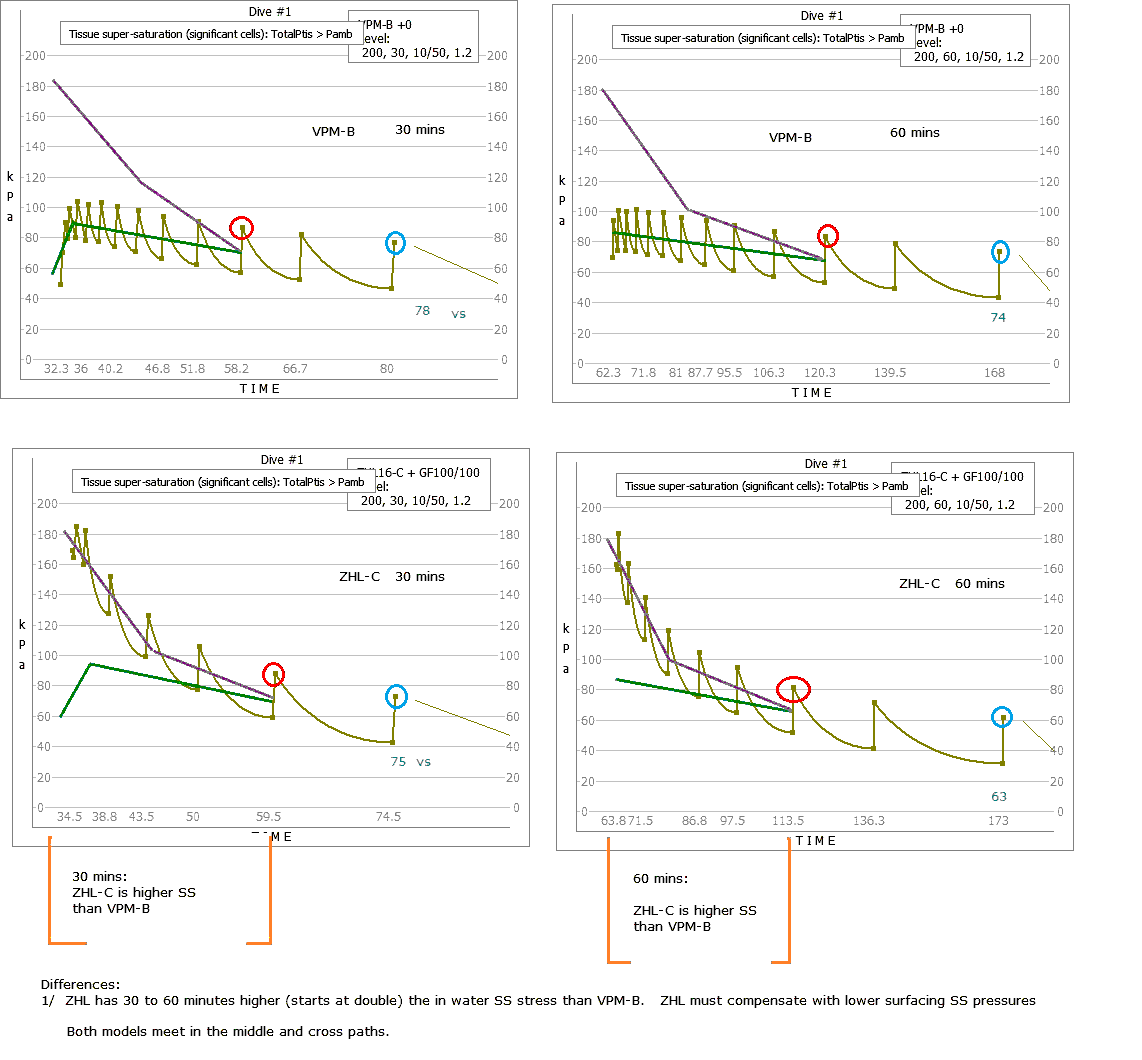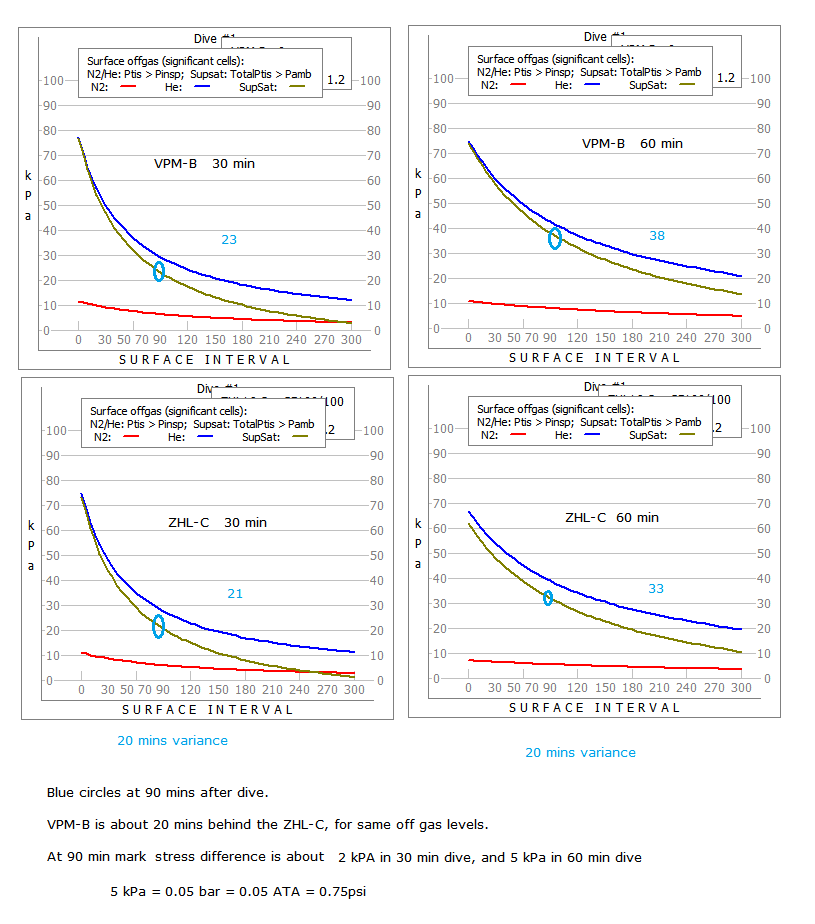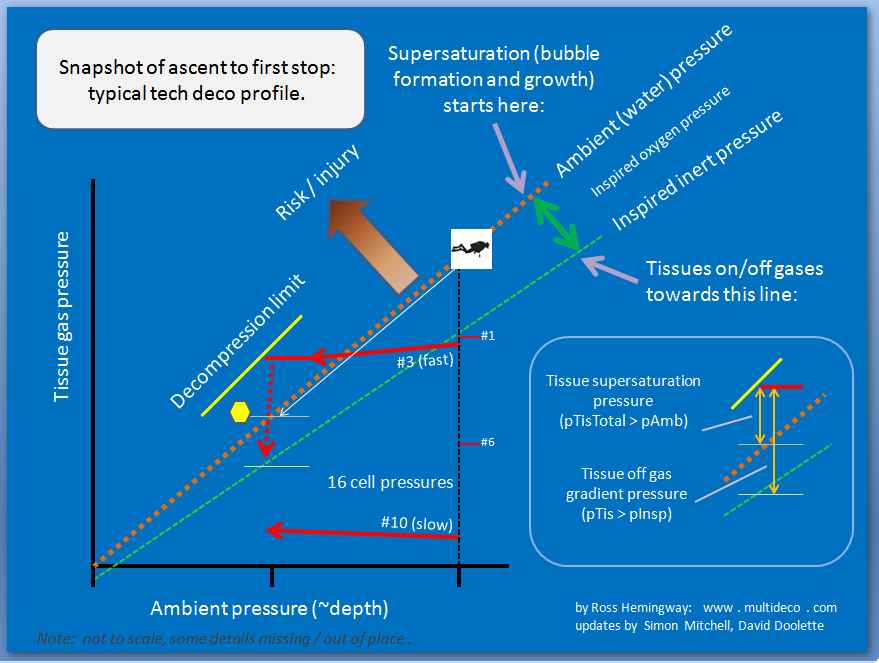Hey Diver0001,
With regard to sufficient shallow time, I’ve seen it posted a lot that VPM "scales consistently and in the right proportions" as you go deeper and stay longer. I have another perspective on that idea. See the chart below.
View attachment 379689
Each of the lines shown on the chart represents the allowed supersaturations for each compartment upon surfacing from dives with progressively longer bottom times (all 200ft dives in this example). For this discussion the actual dive parameters (i.e. CCR or OC, depth, set point, gases) don't matter much. This pattern is reproducible in deeper dives when the effect of the critical volume algorithm (CVA) in VPM wears off. The CVA is that part of VPM that allows it to better reflect NDLs and lighter deco requirements. The important thing to understand about the chart is that we're seeing how VPM-B adjusts in the face of increasing gas loads due to the longer bottom times and deeper dives many tech divers are familiar with.
I added the black-dashed line to highlight something. Notice that the peak supersaturation that the diver is allowed to surface with doesn't change (or changes very little) as the bottom time increases (following CVA wear-off). Even staying within VPM theory you have to see the problem with that.
Suppose you execute the 40 min dive. Based on the chart the peak SS at surfacing is in compartment 11. If you move to a bottom time of 60 min C13 has the peak SS at surfacing. C13's half-time is about 63% longer than C11's. That is, C13 will stay supersaturated far longer because it's a slower compartment. But what has VPM done? It's kept the supersatuation at which the diver is allowed to surface the same (oh, there may be minor differences, but they are effectively equal as shown on the chart). VPM methodology allows the same supersaturation upon surfacing even though it must be endured for a much longer time. This approach can only do one thing --- increase risk. The diver, then, must know to increase VPM's conservatism or substantially pad shallow stops to adjust for this, or accept the certainty of increasing risk, because VPM is doing nothing on its own to make that adjustment. The lack of sufficient shallow time is directly related to this "feature".
So in response to the idea that VPM "scales correctly and in the right proportions" I would say the following. It's not so much that VPM doesn't scale correctly, it's that it doesn't scale AT ALL, at least in the sense discussed above. There is no attempt in the face of mounting gas loads in slower compartments to decrease allowed supersaturations to reflect the far longer SS exposure.
In comparison, GF does reduce allowed surfacing supersaturations as slower compartments enter the picture because Buhlmann's M-values get smaller as compartment half-times get longer. I'm not saying it adjusts perfectly to keep risk the same. But it does reduce allowed supersaturations as more gas is loaded in slower compartments. So in that sense GF "scales better and in better proportions" than VPM.
For comparison, see the charts below for GF and for a Navy Mk16 set of dives. Notice the negative slope in peak allowed surfacing SS as dives become more extreme and slower compartments become more important. Again, I can't claim the adjustment is enough to keep risk the same, but at least they're playing the right game.
View attachment 379690
For completeness, this pattern occurs when dives are extreme enough to minimize the effect of the CVA and long enough so that, for any given depth, the first stop isn't changing drastically as time increases-- basically technical dives with longer decompressions.
Ah yes... real models vs GF... 40/ 70, no this time use 60/ 85, ....... no it looks better if we use 65/72.....
 You see... all this GF fudging to make your graph look perfect...... "My stretched out GF , tailor made, fitted to perfection GF fudge looks just perfect".
You see... all this GF fudging to make your graph look perfect...... "My stretched out GF , tailor made, fitted to perfection GF fudge looks just perfect".******
Mean while, back in the water, where the actual problem of DCS and Supersaturation stress begins.....

Don't forget the basics - an excess of supersaturation pressure, is the basis of all (type2) DCS injury. Here we see ZHL is (much) higher stresses, for the first 30 to 60 minutes of the ascent.
You can argue all you want about the necessity of reducing fast tissue supersaturation and its effect. But take a look above. VPM-B has lower supersaturation pressure for 1 hour of the ascent - that's long past 'fast tissue' state. This translates to a much lower in-dive stress factor, a lower over-all starting point for stress status when surfacing. This is clearly worth some allowance for permitting a little different stress on the surface.
A DCS injury is the product of both dive and surface stresses. ZHL-C and VPM-B go about doing the job differently.
*****
Added
You can see that both ZHL-C and VPM-B have both lowered the allowable surfacing pressure between the 30 and 60 minute examples. They are not equal amounts, but then neither is the in dive stress levels.
Last edited:







